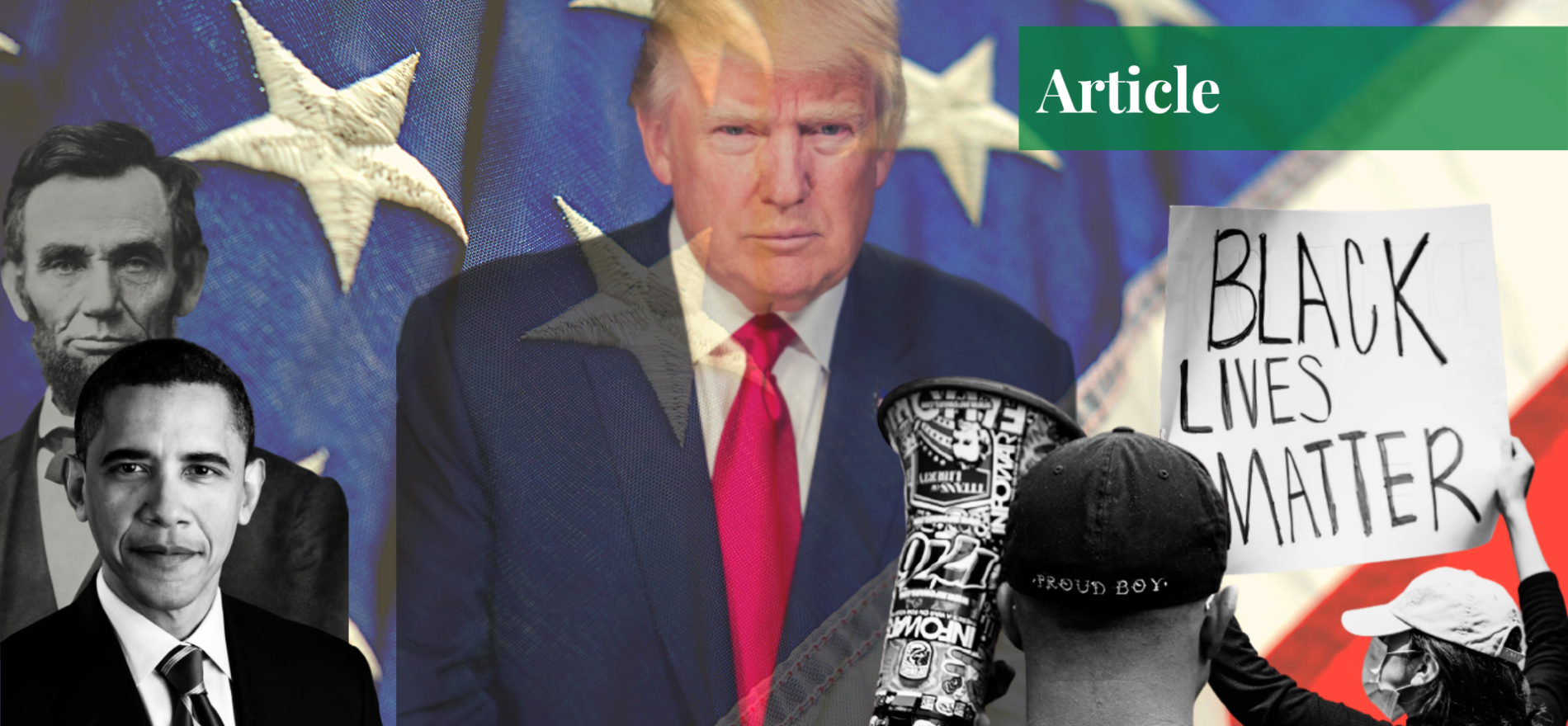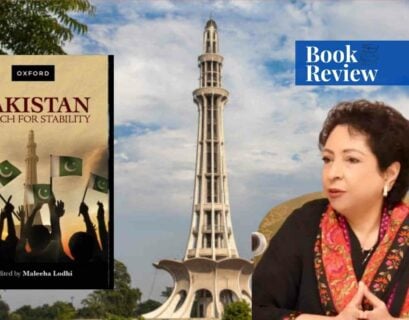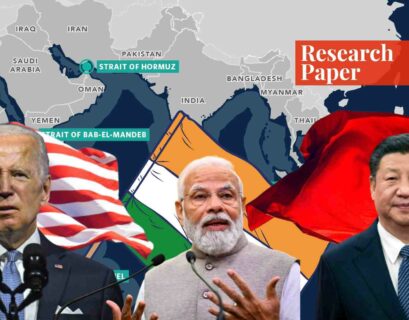Sarmad Ishfaq is an independent researcher and writer whose work has been published by Harvard Kennedy School Review, The Diplomat, Open Democracy, Paradigm Shift, Mondoweiss, and Eurasia Review to name a few. He has also been published by several international peer-reviewed journals such as Taylor and Francis' Social Identities. Before becoming an independent writer, he worked as a research fellow for the Lahore Center for Peace Research. He has a master's degree in International Relations from the University of Wollongong in Dubai where he was recognized as the 'Top Graduate'.
The Second U.S. Civil War
Claiming that a U.S. civil war might happen in 2020 or 2021 seems like a ludicrous statement but according to author Elizabeth Drew, “America’s capital is more on edge now than at, perhaps, any other time since the eve of the Civil War in 1860,”. As the title suggests, the article is more concerned with why a civil war appears to be looming after the U.S. elections rather than focusing on which candidate will emerge victoriously. In fact, in my humble opinion, whatever the election outcome, a civil war-like scenario will loom overhead the U.S. regardless.
Since Trump’s ascendancy to the American presidency, the fissures in American society have become transparent and more pronounced. These fissures, as the article will discuss, are primarily related to the left-right (Democrat-Republican or liberal-conservative) divide in the U.S – and will be hard to mollify.
Some might consider the title an overstatement, but studying American society under Trump exposes how dichotomous the nation has become. This kind of extreme divide seemed inexistent or at least obfuscated when Obama was in office. Whether a full-fledged civil war or a similar situation takes place right after the elections or over the next few years is difficult to predict, but something has to give.
The Left-Right Divide
Trump’s hardcore base consists of White Evangelicals as well as other conservative Americans. Some, amongst these folks, lean more extremely to the right than others such as neo-Nazis and alt-right groups. Conversely, even before the election, many liberal or left-leaning Americans despised Trump and partook in many rallies held to oppose his election. To their dismay and the right’s delight, he won.
Almost as soon as his victory in the 2016 election, the media, especially the left-leaning outlets, started reporting about the rise of far-right and radical groups in America who supported Trump. Media reports of white supremacists holding rallies and displaying their approval of Trump by doing the Nazi salute became commonplace for some time – obviously angering African Americans and the left.
Far-right people in Trump’s cabinet such as Steve Bannon, former chairman of Breitbart, a far-right publication, were repeatedly called out by the press. CNN and their viewers lambasted Trump and his “radical supporters” – at times justifiably while at others, not so. There was a huge women’s march in Washington to protest the first full day of Trump in office. In solidarity with this main march, large crowds gathered in all 50 states and around 3-4.5 million people marched all over America making it one of the largest protests in U.S. history.
It was only a matter of time for the anger of the left to meet the vehemence of the right. In fact, as far-right groups emerged after Trump’s victory, the “extreme” of the left, too, revealed its head in the form of Antifa. Antifa is a far-left group that opposes fascism and relies on both violent and non-violent means to achieve its objectives. However, Antifa (and the far-left) are not nearly as dangerous as the far-right groups.
Charlottesville and the Old Civil War
One of the foremost places where the left-right clash materialized was in Charlottesville, Virginia, in August 2017, where it was proposed that the statue of General Robert. E. Lee should be removed. Robert E. Lee was a seminal figure in the American Civil War who fought on the side of the Confederacy. The American Civil War was fought between the southern states (the Confederacy) which were pro-slavery and the northern states (the Union) which were anti-slavery. The latter led by Abraham Lincoln won and slavery stood abolished.
The “Unite the Right rally” in Charlottesville was made up of white supremacists and neo-Nazis who opposed the decision to remove Lee’s statue – as well as other Confederate monuments. The protest was “the largest and most violent public assembly of white supremacists in decades.” The protesters were confronted by counter-protesters from the left including Antifa and a huge clash ensued that took three lives and injured dozens.
A state of emergency was declared and the morality of having Confederate statues in public spaces became the primary talking point on the news for weeks. While some argued that the Confederacy, right or wrong, is a piece of American history and should not be wiped away, others retorted that these statues of slave-owners and slavery-supporters should not be displayed heroically in public spaces.
Many local governments in the coming weeks removed many Confederate statues. Trump denounced the violence but was irrevocably against the removal of the “beautiful” statues. America, it appeared, stood at the precipice. Charlottesville was a watershed moment as white supremacist-centric violence proliferated and far-left groups like Antifa re-emerged – however, the “extremism” factor was far more pronounced on the right than the left.
Since Charlottesville, white supremacists have committed at least 73 murders. Donald Trump, unfortunately, never took a rigid stance against the white supremacists and far-right hate groups, and many claim that this emboldens them. Instead, Trump denigrates the far-left, particularly Antifa, for inciting violence, which subsequently divides America even more.
For example, in response to the clashes between the Proud Boys, a neo-fascist group, and Antifa members in Portland in 2019, Trump tweeted “Major consideration is being given to naming ANTIFA an “ORGANIZATION OF TERROR.” However, Antifa’s threat is gravely exaggerated by the Trump administration.
The Far-right Is More Dangerous but the Left Knows How to Protest
“Far-right extremists were behind two-thirds of the attacks and plots in the U.S. in 2019 and more than 90% in the first half” of 2020. In 2019, a white supremacist targeting Latinos in El Paso took the lives of 23 people and injured 23 others. The far-right consists of many distinct yet similar groups such as the Proud Boys, the KKK, and the Boogaloo Boys.
A recent report conducted by the Center for Strategic and International Studies found that left-wing terrorism had led to the deaths of zero victims since 1994, while over the same period, 329 people died due to right-wing extremism. Despite this, Trump’s administration has constantly faulted “far-left fascism” as the specter but has not mirrored the same emotion when it comes to the far-right.
The President has formerly “recoiled at criticizing even his most extreme supporters, including white supremacists.” Even when his own FBI director, Christopher Wray, stated that white supremacists were the greatest domestic terrorist threat today in America, Trump remained unfazed. As far as far-left groups go, Antifa, a loose amalgam of leftist groups, is one of the only entities that has been “directly and sometimes physically confronting the far-right on the streets.”
Although generally they are not considered nearly as dangerous as the far-right, they are still a threat, since if their presence coincides with far-right Trump supporters, temperatures could rise. In fact, it has been their objective to engage in counter-protests when the far-right is protesting in the streets – hand-to-hand combat can ensue in such scenarios.
Since gun-related and hate crimes have increased post-Trump’s arrival, the debate between the left and right vis-à-vis gun control has amplified. Traditionally, American conservatives have held the Second Amendment close to their hearts that allows Americans to bear arms; many Republicans personally own weapons or belong to households that do.
While owning arms is legal, the rise in white-supremacy-related crimes has enabled the left and the media to heavily clamor for more gun regulations or complete repeal of the Second Amendment in recent times. The right with the enormous persuasive power of the NRA (National Rifle Association), one of the most influential advocacy groups in the U.S., will never let that transpire – they argue that guns are definitely not the issue.
In such a perilous social and political climate, it is, therefore, not surprising that the huge masses of moderate (non-violent) liberals have a severe antipathy to Trump. From the ignominious “Muslim ban” to the recognition of Jerusalem as the capital of Israel, many protested throughout Trump’s stint to oppose his policies.
Although the left, including the far-left, are not as weaponized (and dangerous) compared to their counterparts, they have been more effective in organizing protests and delivering considerable numbers throughout America. Muslims, African Americans, Latinos, and left-leaning Whites have shown their distaste for Trump by launching a plethora of marches, protests, and rallies in recent years.
The Women’s March broke records, while others throughout his presidency brought in a respectable amount of the populace. Protests like the Impeachment March, Tax March, Day Without a Woman, Day Without Immigrants, etcetera all left their mark. Young people and left groups channeled their dispiritedness and contempt in political activism.
The Washington director for MoveOn.org, Ben Wikler, stated that the grassroots energy (vis-à-vis protests) exploded like a volcano. Left-aligned groups have traditionally not worked well with each other but have united in contemporary times in their dismay for Trump. Even the historically apolitical economic sector such as the tech industry saw an upsurge in political activism and protested against the braggadocios Trump.
Coronavirus and George Floyd
The United States is hemorrhaging due to coronavirus. The nation remains the worst-hit country by the pandemic, with around 9.16 million cases and 230,000 deaths. The economy is noticeably struggling due to businesses closing down and unemployment skyrocketing – over 40 million Americans have lost their jobs due to COVID-19. Needless to say, frustrations remain high. During this pandemic panic, the killing of George Floyd by a white police officer turned America on its head.
Protests erupted not just nationwide but also internationally. Black Lives Matter (BLM) and other (primarily left-leaning) groups spearheaded the protests that drew millions of people around the U.S. – around 15-26 million people had taken part at some point in the demonstrations in America. Although many protests were peaceful, rioting began to take place in some cities. Clashes with the police and counter-protesters became the norm in certain areas.
Around 200 cities in the U.S. had curfews imposed by June 2020. The police had become the primary verbal, and sometimes, the physical target for many protesters. Slogans like “Defund the police” and “I can’t breathe” echoed throughout the nation. Trump criticized certain mayors for not taking stricter action. The National Guard was eventually mobilized in a dozen states as well as in Washington D.C. to control the riots – it was bedlam.
Due to the deteriorating law and order situation and anarchy in the streets, Trump berated Antifa and the far-left as he alleged that they were using the George Floyd protests to forward their agenda of chaos. The left-right divide reared its ugly head once again. Mimicking Trump, some of his more zealous supporters also began stating that the protests had been hijacked by Antifa.
The proof for this was lacking as among hundreds of arrests made during the protests in five of the biggest Texan cities, only three were allegedly Antifa related – and even these looked dubious. This is not to say that rioting and unlawful activities were not going on, but that Trump’s blaming Antifa appeared to be scapegoating. He repeatedly threatened to bring in the military to take control of the worst-hit areas and urged the police to come down hard on the protesters.
Although the protests initially were anti-racism and reform-oriented in nature, due to Trump’s cavalier and divisive attitude, he became a target of the protests later on. People made their vehemence known against Trump by eventually protesting outside the White House. In response, Trump tweeted that the protesters would be met with “the most vicious dogs, and most ominous weapons” he has ever seen.
What traumatized others more was Trump’s threat to use the Insurrection Act, an act that allows federal troops to be used for domestic law enforcement, to pacify the situation. Even his own Defence Secretary criticized this statement. During the George Floyd protests (and subsequent rioting), another far-right called the Boogaloo Boys became prominent.
The group is an anti-government entity that claims to be preparing for or want to usher in a second American Civil War – yes, you read that correctly. However, they appear very heterogeneous in their proclivities as some seemed to support the BLM movement and were anti-police, while others were white supremacists seeking to instigate violence during the riots.
Since 2019, around 30 people associated with the Boogaloo movement have been arrested and five deaths linked to this group. A U.S. Air Force sergeant associated with the movement killed a deputy sheriff on June 6, 2020. The group shockingly was also planning the kidnap of the Democratic governor of Michigan, but the FBI derailed this plan.
The Aforementioned Plus Trump’s Electoral Rhetoric
With the aforementioned indelible schism in American society, voters are set to elect their next president soon – millions have already voted. Conflated with such an egregious divide between America’s left and right, Trump’s electoral rhetoric, in my opinion, is causing the most problems. For months, Trump has claimed that the Democrats would rig the elections.
At a Republican convention, he uttered, “The only way they can take this election away from us is if this is a rigged election.” Due to the coronavirus, many people will, and have voted, through mail-in ballots. Trump has repeatedly made false claims about mail-in ballots vis-à-vis how they are cast and counted.
Trump has bellowed that the mail-in voting will result in “the most corrupt election” in American history. Biden has responded by saying that Trump is “trying to sort of delegitimize the election.” The Democrats have retorted similar sentiments, claiming that Trump is merely trying to make excuses and save face if he loses, especially since Biden leads comfortably in almost all national polls.
While what the Democrats are saying might be true, this does not mean Trump’s rhetoric is not dangerous and not inspirational to his hardcore supporters. Videos of Trump supporters and far-right militias asserting that if he does lose the election, another civil war is likely, are pervasive online. “Millions of Americans are bracing for trouble no matter who wins.” Americans have begun stockpiling food and munitions to prepare for the worst-case scenario.
Since “Donald Trump has refused to commit himself to a peaceful transfer of power if he were to lose…” the stage is set for some sort of fight. He has told the Proud Boys “to stand back and stand by” during a presidential debate. Experts have also cited a rise in unofficial militia activity as the election draws closer.
Several unofficial militias are “vowing to show up to polls heavily armed.” With respect to militias, David Skaggs, a former Democratic congressman, indicated that the pro-Trump militias would “probably rise to arms if the president said they should, and that would be awful.” Regardless of who wins the election, things are going to escalate yet another time in recent American history.
It is fairly safe to state that some degree of civil strife and perhaps violence will immediately take place after the elections. However, whether this strife deteriorates into a full-fledged U.S. civil war straight away in 2020 or at a later stage, only time will tell. It is my humble opinion, though, that a civil war is imminent in the United States – eventually.
If you want to submit your articles and/or research papers, please check the Submissions page.
The views and opinions expressed in this article/paper are the author’s own and do not necessarily reflect the editorial position of Paradigm Shift.



















